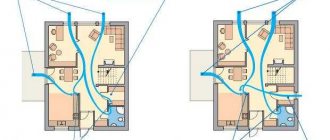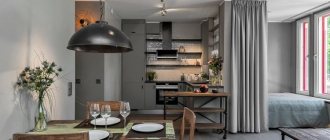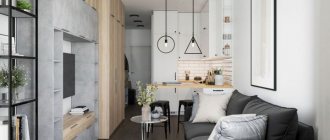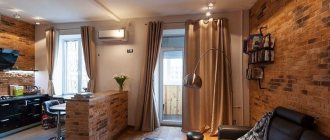With the amount of clothing and shoes for all seasons, accessories and hats that the average modern family accumulates, a separate place to store them is not a luxury, but a vital necessity. Running around the whole house, rummaging through closets in search of a lost strap or jumper, is very inconvenient and takes a lot of effort and time. Organizing your closet eliminates unnecessary hassle. It especially makes life easier for mothers with 2-3 children of different ages, each of whom needs to be ready for kindergarten, school, or for an outing.
When all the clothes are laid out and hung in an order convenient for household members, in one specific place, there are no questions about the location of a replacement pair of shoes, an autumn windbreaker or a tie for a specific shirt.
It is not difficult to arrange the available free space for a dressing room. Even a small nook, niche or former storage room, with an area of no more than 1.5-2 m2, will do. If a large size option, up to 4-6 square meters, fits in an apartment or house, this will be ideal. In such a room you can place a full-length mirror, a comfortable chair or banquette, and change clothes there. We will tell you about all the secrets of creating dressing rooms in this article.
Advantages of a dressing room
Storing personal belongings and accessories in one place makes it easier to get ready for work in the morning and carry out periodic cleaning. Arranging a proper dressing room has a lot of positive aspects:
- Availability of additional storage area. In the room you can organize wall shelves and racks, equip cabinets with hooks and racks for shoes, and build racks for umbrellas.
- You can move bulky chests of drawers and drawers for things into the dressing room. By getting rid of closets in the bedroom and living room, the owner frees up space for other purposes.
- In a new room, you can install a full-length mirror, which allows you to evaluate your appearance immediately before leaving the house.
- A compact dressing room can be arranged in a spacious hallway, in a wall niche. The most successful solutions are projects for placing dressing rooms in a private house (in the attic, under the stairs to the second floor, on the first floor with glass partitions).
The advantages of such an idea include a huge number of ready-made design projects with drawings of future dressing rooms.
The master can only find and print a suitable diagram for the job. An alternative option is wardrobe cabinets in the room (used for studio apartments).
Types of dressing rooms and layout
Dressing rooms can be closed or open. The first are isolated, self-contained rooms with a door. The second, consisting of racks and drawers, are covered with a light sliding door or screen. Since a niche, an appendix corridor, or any free piece of home is usually used as a dressing room, its layout depends entirely on the geometry of the allocated area.
A linear (one-sided) dressing room is in most cases located in an alcove that complements the bedroom. The width of such storage, including the fitting area, must be at least 1.2 meters.
A corner dressing room occupies a corner of the main room, separated by a partition or sliding door. The racks are mounted along adjacent walls, leaving a patch in the middle for dressing.
The radius dressing room, round and smooth, looks especially impressive in the corner. True, it is, to put it mildly, difficult to implement this in a small apartment.
An L-shaped dressing room is the best option if for some reason you need more space for fitting. In such a room, storage systems are also adjacent to the walls - long and short.
The U-shaped layout is no less convenient, but requires significant space. The depth of the U-shaped dressing room must be at least 2 meters in order to freely choose clothes with the door closed.
A double-sided walk-through wardrobe is perhaps the most economical type. They equip it in aisles and corridors, placing racks parallel to each other along the walls.
Optimal room layout
A classic example of the interior layout of a dressing room includes the presence of multi-tiered shelves, cabinets or chests of drawers. All these pieces of furniture are arranged linearly so that there is free space in the center of the room. Also, a traditional dressing room should have:
- Racks without fronts on which to store boxes, winter clothes in the summer season, old toys. The wardrobe must be spacious enough to fully perform its functions.
- It is worth placing a mirror between the cabinets. This can be either a full-length mirror or a small boudoir equipped with lamps.
- Rows of hooks should be placed on the side panels of cabinets on which hats, ties, and waist belts are hung. This nuance will allow you to efficiently organize additional storage space for small household items.
- There must be a closet with a central axis and hangers on which outerwear is stored. This approach allows you to maintain the neat appearance of your coat, jacket, fur coat or jacket.
- A small dressing room must be equipped with mezzanines, which increase the storage area.
Umbrella stands, as well as racks for storing shoes, are moved from the hallway to the dressing room.
In the middle of the room you can place a small wicker rug on which a soft ottoman is placed. The rules for organizing a dressing room depend on the size of the room and its location in the house.
Everything on the shelves: ways to fill your dressing room
It should be kept in mind that clothes that are rarely used are stored on the upper “floors”. As well as travel bags and suitcases. Shoes are kept at the bottom, and things of the current season are kept in the middle.
All wardrobe items in compartments, shelves and drawers are sorted:
- by season and demand (non-seasonal higher and further);
- purpose (everyday, universal closer);
- completeness (blouses, shirts next to matching skirts and trousers);
- color scheme.
This last layout principle may seem unnecessary. But not for women, for whom the dressing room is a place of strength and inspiration.
Drawers can be equipped with special stickers, hints about what they contain. Or paste photos of things stored inside.
In any case, home owners will have to mobilize both rational thinking and imagination in order to place clothes and accessories conveniently but stylishly. You can also decorate the dressing room: lay a bright, shaped rug on the floor, place a vintage mannequin in the corner, hang a straw hat as a decoration... Although, of course, the main decor for this room is systematic order and absolute cleanliness.
Organization of the ventilation system
There are a number of important rules in the construction of a wardrobe that allow you to use the room for a long time and with high quality. First of all, the master needs to take care of the ventilation system. In a closed room, if there is no regular ventilation, a musty smell appears, and fungus can develop on the walls and things.
This issue is especially relevant for small dressing rooms and rooms where outdoor shoes and outerwear are stored.
High humidity quickly compromises the cleanliness and hygiene of a room. As a rule, 2-3 transoms and 1 ventilation shaft are installed in a closed dressing room.
Note!
- Design of a small bathroom 2, 3, 4, 5 sq. m. (140 photos): new items, beautiful finishes, ideas for mixing and matching
- Children's room for a boy: TOP-150 photos of new designs, layout, zoning ideas, selection and placement of furniture
- Apartment design in a panel house: 100 photos of an ideal layout and a successful combination of interior elements
Optimal dressing room sizes
So, let's decide where the dressing room will be in your apartment and how to correctly determine its size.
What are the criteria for doing this? As you know, a dressing room is intended not only for storing things, but also so that these things can be put on at any time. This means that, firstly, a large amount of clothing should hang on hangers, and secondly, a significant part of it should be in plain sight. Here's what can be stored in a dressing room
. The classic dressing room stores:
- casual wear,
- seasonal clothes,
- underwear,
- socks,
- shoes,
- bags,
- handkerchiefs,
- accessories and decorations.
In general, all things used for daily wear. In addition, large household supplies and household appliances, such as a vacuum cleaner, ironing board, etc., often find their place in the dressing room, which is located in the apartment.
The area of the dressing room should ideally be 10–12 m2 for each person living in the apartment, and a feature of its arrangement should be a large number of open shelves.
Agree, not everyone can afford such dressing rooms. Not only is this the area of a standard living room, but they also require frequent cleaning, which takes a lot of time. Owners with good incomes usually entrust this work to a housekeeper. Small dressing room
It is clear that in an ordinary apartment the dressing room will be much smaller. But, nevertheless, let's decide on the sizes. It would be good to allocate at least 3–5 m2 for the dressing room and leave a small space free so that you can change clothes comfortably. It is advisable to make a fairly spacious entrance to the dressing room. Its width should be at least 1 m. It is best to choose compartment doors to save space in both the dressing room and the adjacent room.
Indoor lighting
Another important nuance of independent work is the organization of high-quality lighting. All work on laying communication lines and placing sockets is carried out at the preparatory stage (interior finishing). The most optimal placement of the following lighting fixtures will be:
- 1 ceiling chandelier or lampshade.
- Several wall lights.
- For boudoirs, you can install several spotlights, and run LED lamps along the walls.
High-quality lighting will favorably emphasize the style of a small dressing room, and will also allow you to quickly and easily get ready for a trip, a festive evening, or work.
Dressing room in the pantry
Without occupying separate rooms and preserving the footage of the living space, they choose to design a dressing room in the pantry. You don’t need a lot of space for this, 1.5-2 square meters is enough. This room can accommodate small quantities of hangers and ordinary boxes. But even an optimal dressing room will save the owners from problems with clutter and placement of things.
It won’t be possible to put a closet or other furniture in the pantry, so you can build ordinary rods at an acceptable height from the ceiling and arrange neat shelves. Proper space planning will improve the efficiency of your dressing room. Grids are installed under shoes in the closet; they make it possible to place the necessary things in a row.
Step-by-step construction of a wardrobe
Before starting any construction work, you should prepare a drawing plan in advance, which shows the dimensions of the dressing room, the location of all cabinets, shelves, and boxes.
It is imperative to indicate the outlet points and the placement of all lighting fixtures. If you wish, you can use a ready-made project.
Furniture
Try to find a place for a large floor-length mirror. When choosing a set of clothes, it is very inconvenient to go to the hallway or another room with a mirror every time. Moreover, you will immediately pick up shoes, a handbag, gloves, and a scarf, and then evaluate the resulting image from head to toe.
A soft bench, ottoman or bedside table that you can sit on while trying on shoes will not be superfluous.
While putting things in order, searching and rearranging things, the contents of the shelves need to be laid out somewhere. Therefore, you may need a folding table or other horizontal furniture with a plane that will help you out at such a moment.
And, by the way, a dressing room is not a woman’s whim. Representatives of the stronger half also appreciated its convenience.
What you need for work
It is very convenient to arrange a dressing room in an already finished room (for example, in a closet). However, this situation does not always occur - more often construction starts from scratch. To work, the master will need a number of tools:
- Jigsaw for working with wooden surfaces.
- A plane and sandpaper are used to sand the surfaces.
- Moisture-resistant oil is a universal composition that gives wood resistance to moisture, rot, fungus and pests.
- Compositions for decoration (paints, acrylic varnish, PVC films or decorative veneer).
- Fastening kits. Shelves and racks are connected to each other using self-tapping screws, metal corners, and dowels.
- Additional accessories in the form of hooks and racks can be purchased at any construction supply store. There, the master will have to buy rotary fittings, grooves, rollers, and handles for installing doors.
- A tape measure, building level, pencil or marker are indispensable assistants in any independent work.
If you plan to work with metal structures, you should stock up on a grinder, welding, and anti-corrosion compounds in advance.
Note!
- 10 free programs for interior design and planning an apartment or private house: a review of the best online resources for design
Design of small rooms (200 photos): examples of ideal design, choice of color and style, layout and zoning
- Stretch ceiling with lighting (around the perimeter, from the inside): photo of modern design, color choice, materials, sizes, price
Pre-treatment of all surfaces can significantly extend the life of products, cabinets, and shelves. For inexperienced craftsmen, it is better to first watch a series of training videos on how to make a dressing room in a room.
Interior decoration
Having chosen the location of the future dressing room, we begin to decorate the interior of the room. If a wooden or plaster partition is used as the outer frame, as a rule, this step is skipped. For a full-fledged new room you will need to carry out a number of finishing works:
- All walls and floors will be checked for rough cracks, joints, and unevenness. Repairs are carried out if necessary.
- It is important to treat the walls before painting or wallpapering with a primer and an antiseptic. Protecting personal belongings from damage is one of the key tasks of the master.
- Ceramic tiles, laminate, linoleum can be used as flooring. For walls, it is better to use liquid wallpaper or decorative plaster.
It is at this stage that work is carried out on installing sockets, laying communication lines and organizing ventilation grilles. The design of the dressing room can be anything, depending on the personal wishes of the owner.
Selection of finishing materials
Usually the dressing room is decorated in the same way as the room adjacent to it. You can use other materials, but they must be combined in both rooms. However, the use of wallpaper is not recommended, as it accumulates dust very well.
When decorating a dressing room in an apartment or house, preference is given to both natural and environmentally friendly materials and artificial finishes, which are more economical and budget-friendly.
Tree
This is an environmentally friendly material with good moisture absorption and high aesthetic characteristics. However, using it to decorate a dressing room is not the best idea due to its high cost. Even a small chip can deprive the finish of its former attractiveness.
A light wood wardrobe will add a touch of luxury to the interior.
Chipboard and MDF
These are practical and inexpensive materials that are quite easy to install without the risk of damage. They have an impact-resistant edge that protects against chips and scratches. Also, chipboard and MDF are presented in a wide range of colors, which will make the design of the room more interesting.
A wardrobe made of MDF is a practical and inexpensive option.
Plastic
Highly decorative material with a variety of colors and textures. Plastic is unpretentious, does not require special care and does not accumulate dust. Also, its installation is extremely simple, and the price is quite affordable. The disadvantage is its airtightness, due to which it can only be used in dressing rooms with good ventilation.
A plastic wardrobe is suitable for placement in a children's room.
Installation of cabinets and shelving
The main and most critical stage of the master’s work. Step-by-step making of a dressing room with your own hands:
- Finished cabinets and shelving are installed along the walls.
- For homemade cabinets, you will need to pre-assemble the structures. Fastening shelves and furniture to the underlying walls is mandatory, which will ensure safety for future owners.
- Along one of the walls, two horizontal strips (metal pipes) and one vertical stand are mounted. The central axes are designed for storing outerwear on hangers.
When installing (or making shelves yourself), it is important to ensure that their depth and the height between adjacent panels is sufficient for storing boxes and suitcases.
Note!
Children's room for a girl: TOP-200 photos of modern design, layout, zoning, selection and placement of furniture for the nursery
Unpretentious indoor plants - review of the best options for apartments and private houses (photos and names)
- Design of a plasterboard ceiling: new items, photos, types of construction, the ideal combination in the interior of a kitchen, bedroom, living room
How to make a dressing room: placement options
In a house, a storage room is also assigned at the design stage or later when allocating a room. They are rarely found in standard apartments. Therefore, it is necessary to find a suitable solution. Let's look at several possible options for what and where you can make a dressing room with your own hands.
In the hall
It’s good that the owner has a large room at his disposal, part of which can be removed to organize a storage system. In this case, a partition is placed dividing the corridor into two rooms. The size and shape of the wardrobe are selected taking into account your preferences. In small apartments, there are two solutions for how to design a dressing room in the hallway. The first is intended for long but fairly large rooms.
There is a filing cabinet on one of the walls. It is optimal to choose a closed wardrobe, possibly with mirrored doors. This will visually expand a small space. The second option is for square or cramped layouts. In this case, the corner is fenced off with a partition, and a storage system is installed inside it.
Under the stairs
The free space under the flight of stairs is deep enough to accommodate a storage room. There are many options for arrangement. You can make a closet either open or with doors: sliding or hinged. A modular design, which is assembled from retractable or retractable elements, is also suitable. Hooks, crossbars, shelves, and drawers are placed inside such blocks.
Out of the closet
A boring wardrobe can easily be converted into a wardrobe if desired. The layout depends on the available space. The filling is pulled out of the old cabinet, leaving only the frame, which will become the basis of the new design. It is installed in place and the filling is installed.
It can be done differently. Use old furniture as closet storage. Take some elements without changes, change them and repeat something.
In the bedroom
It is customary to store clothes in the bedroom, so this solution is considered very appropriate. The space for the storage system is determined based on the shape of the bedroom. If it is too stretched, it is best to fence off the area across the room.
The bedroom will acquire the correct proportions, become more comfortable and attractive. In fairly spacious, square and adjacent rooms, a corner placement of the dressing room is preferable. It is separated by a permanent partition with doors or a thick curtain.
From a niche
If the size of the niche allows, shelves and shelves are arranged inside. All that remains is to install the doors: hinged, sliding or compartment. The cabinet can be left open, but it should look attractive and neat, or covered with a thick fabric curtain. Small niches are complemented by a plasterboard structure that expands to size.
In the pantry
Older apartments often have a small, windowless room called a closet. Usually its area allows you to place a full-fledged dressing room in the interior. The filling can be anything, placed along the walls or the letter G. The door is closed with a curtain or a suitable door is installed.
Dressing room in the attic
This is a less affordable dressing room option. But with the right room layout and furniture arrangement, the attic will be an excellent place for a dressing room. Since this is an attic, it is important to pay special attention to ventilation and vapor barriers. This is necessary to prevent moisture and mold from entering.
Behind the partition
You can arrange the closet behind the partition yourself, without involving specialists. The partition can be improvised or stationary.
Improvisation - using blackout curtains to divide a room. The curtain is attached to the ceiling using a frame or rod. The screen is suitable for a bedroom; behind it you can not only arrange a dressing room, but also store bed linen, and arrange a boudoir there with a mirror with good lighting. But a model with a curtain will hardly look appropriate in the living room.
The second option is zoning with plasterboard, this model is a little more complicated and expensive, but there are no problems with the location, it can be installed in any room. No permits are required for the construction of such a building. This structure can be dismantled at any time.
Choosing a place for a dressing room
A bedroom or bathroom often has a full-fledged dressing room adjacent to it. Often an existing storage room or corridor is converted into it.
The size of the apartment is not the only criterion for arranging a dressing room. Its position is also affected by the structure of the house. An ideal dressing room is considered to be a room with two entrances: from the bedroom and from the bathroom. And also the one that has a window, because in natural light it is more clear, like, for example, a blue dress and yellow shoes will be standing outside.
Remodeled empty closets under stairs, attics, and even patios can serve as clothing storage areas.
In fact, there may be several locker rooms. A man and a woman, for example. Or for seasonal and non-seasonal clothing. Once you decide to clear out your pantry, you don’t need to look for a large space. And use some empty and ineffective corners. For example, for seasonal clothing and accessories - a corner closer to the bedroom or living room. For out-of-season items: a remote closet or space under the stairs.
Installing doors indoors
The wardrobe should be isolated from other rooms, especially from the kitchen, bathroom and bathroom. Installation of door structures will protect personal belongings from moisture, unpleasant odors, and accidental contamination. Doors for a dressing room can be made in several variations:
- Swing structures. The sliding wardrobe room is made in retro style and has a very original design.
- Sliding doors (installation of grooves and movable rollers will be required).
A glass or plastic partition with decorative coating can be used. All available types of doors can be assessed in the photo of the dressing room in various variations.
Dressing room design - photo
[ads_block2]











